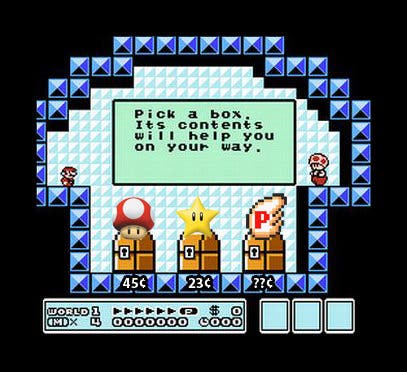Retrospective: Super Mario Bros. 3
Running and jumping.
What tempers the potential frustration, aside from the fact that Mario is almost always scrupulously fair with its difficulty, is the specialised knowledge that would have built up by the time you first turned on Mario 3. Replaying it after the best part of a decade, there are specific things that can help you out, like the creepy sixth sense that still leads you to hidden power-up locations long after you've forgotten the names and faces of university housemates and sixth-from girlfriends, but there were always more general things, too. Things like the knowledge that a Bullet Bill cannon won't fire if you're stood right on top of it, a feel for where the designers like to tuck hidden areas, or an inherited awareness of whether you're far enough away from an oncoming object to throw a Koopa shell with no fear that the game will remember to fling it back at you.
Three titles in, whichever second instalment you're counting, a recognisable Mario universe was coming together nicely, in other words. Mario 3 marks the point where Bowser picked up his penchant for flying galleons, and where his single-parent family situation got a bit out of hand with the arrival of the Koopalings, and it also delivered the first of many letters sent by flustered princesses. Equally, just as the 3D games would often riff on real-world materials for their toy-box assault courses, Mario 3 offers its fair share of ledges with recognisable wood grain, or platforms that are visibly powered by spinning mechanical pulleys.

Most crucially, however, for me at least, the truly killer thing about Mario 3 is the way it stitches its levels together into maps. These little top-down chunks of real estate gave the whole thing a rakish non-linear aspect, obviously, but they also did far more than that. They suggested a broader, more coherent imaginary world in a way that the side-scrolling roads, cliffs, and pits somehow couldn't do by themselves.
These really were different places Mario was travelling through, and they were filled with their own distinct landmarks, such as the head-bobbing shrubs of Grass Land, the sweet archipelagos of Water Land, and Sky Land's spire, complete with bizarre blue pipes and destructible battlements, that corkscrews you upwards into a fresh run of levels set amongst clouds.
Mario's world was suddenly being charted in order for us students and professors of Mariology to pick over afresh, and it ensured that Mario 3 delivered something that, for all their brilliance, I've always felt some of the more hub-centric 3D games have sacrificed: the sense of a journey, the feeling of travelling from A to B as you progress from one distinct environment to the next.
More than most games, I suspect, Mario's history has a habit of blending with the personal histories of its players. That's why I can't play the third instalment without thinking about George and his Lyme disease, and why I can't pick up the second Galaxy without recalling the time I played it so solidly at a three-day review session that I ended up fainting at Paddington Station on the way home and woke up by the turnstile with a huddle of commuters slapping me therapeutically around the face. (Thanks, everyone!)
The thing that sticks in my head the most about Super Mario Bros. 3, though, isn't my neighbour's illness or all that playground squabbling. It's the potential that Nintendo's game seemed to hinting at with every jump, with every dodge, and with every end of level card I collected. Look at what we can already do, it said. Imagine what we'll try to do next.
